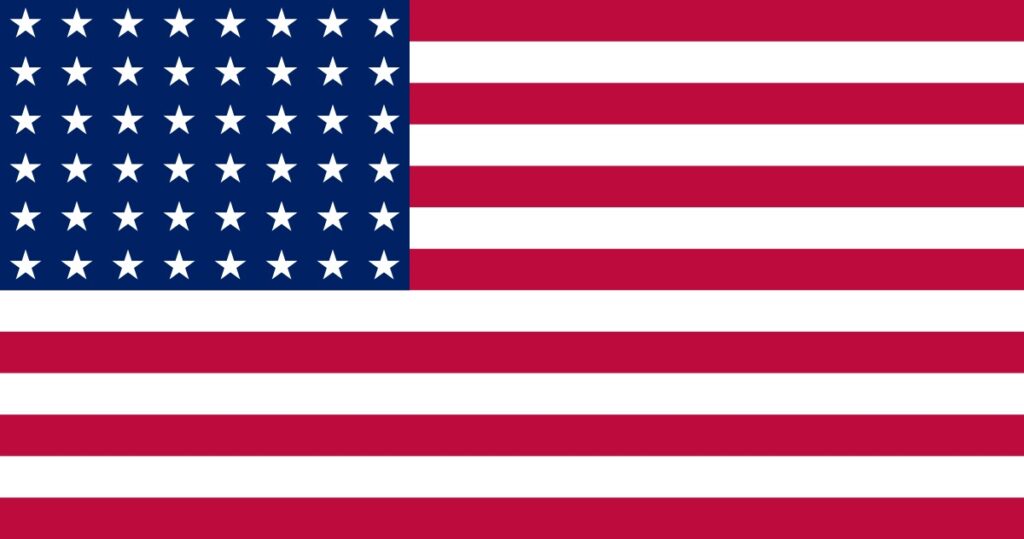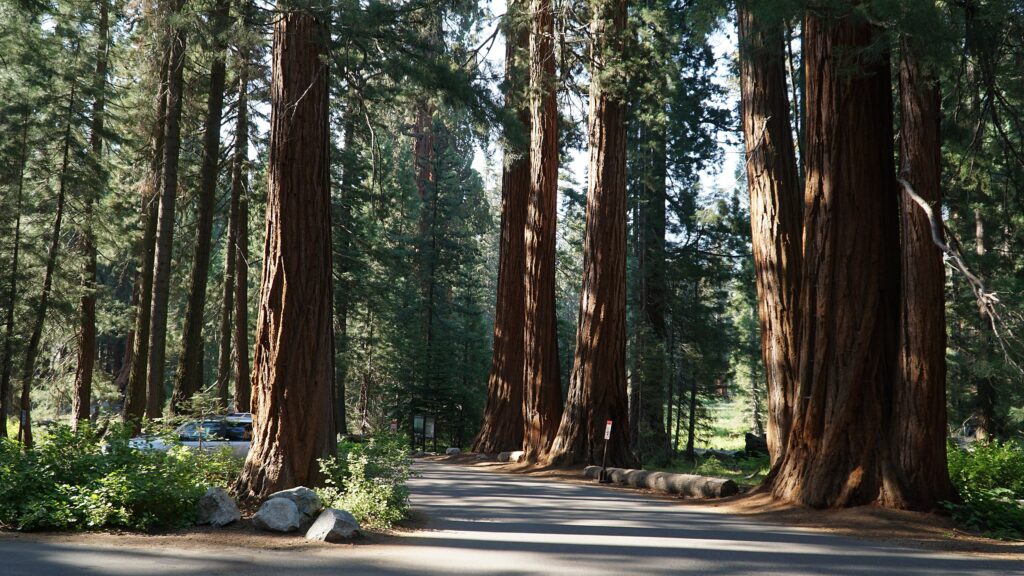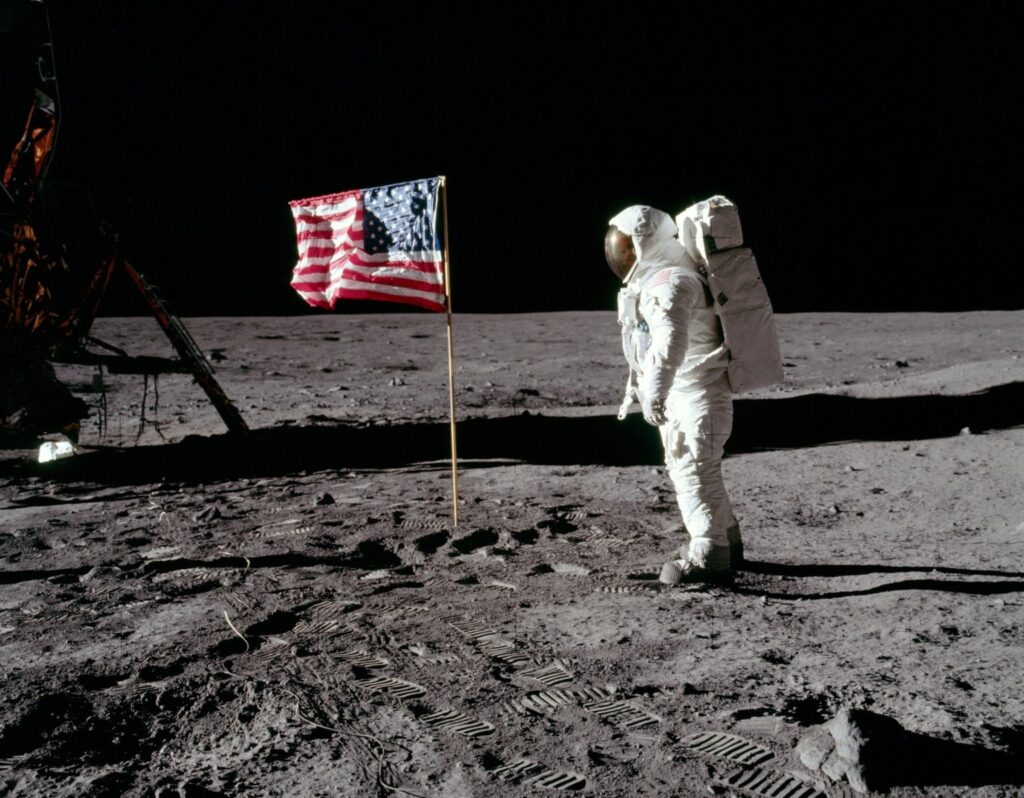Fatti rapidi sugli Stati Uniti:
- Popolazione: Circa 333 milioni di persone.
- Capitale: Washington, D.C.
- Lingua ufficiale: Nessuna a livello federale, ma l’inglese è la lingua più parlata.
- Valuta: Dollaro statunitense (USD).
- Governo: Repubblica costituzionale federale presidenziale.
- Religione principale: Cristianesimo, con una vasta gamma di denominazioni tra cui il protestantesimo, il cattolicesimo e altre fedi.
- Geografia: Situata nel Nord America, confina a nord con il Canada e a sud con il Messico, a est con l’Oceano Atlantico e a ovest con l’Oceano Pacifico.
Fatto 1: Il disegno della bandiera degli Stati Uniti variava a seconda del numero di Stati.
La bandiera degli Stati Uniti, spesso chiamata “Stars and Stripes”, presenta un campo di 13 strisce rosse e bianche alternate che rappresentano le 13 colonie originarie che dichiararono l’indipendenza dalla Gran Bretagna nel 1776. Nell’angolo superiore sinistro, o cantone, c’è un campo blu, noto come unione, contenente un numero variabile di stelle bianche, ognuna delle quali rappresenta uno Stato dell’Unione.
Man mano che gli Stati Uniti si espandevano territorialmente e ammettevano nuovi Stati all’Unione, il numero di stelle sulla bandiera aumentava di conseguenza. Il disegno della bandiera è stato standardizzato con l’ordine esecutivo del presidente William Howard Taft del 24 giugno 1912, che specificava che le stelle dovevano essere disposte in file e sfalsate in modo da creare un disegno simmetrico. L’attuale disegno della bandiera con 50 stelle che rappresentano i 50 Stati è in uso dal 4 luglio 1960, dopo l’ammissione delle Hawaii come 50° Stato.
Prima del 1912, la disposizione delle stelle sulla bandiera variava in base all’ammissione di nuovi Stati. Ad esempio, durante l’epoca della Guerra Civile, i disegni delle bandiere potevano presentare configurazioni con stelle disposte in cerchi, file o altri motivi. Tuttavia, dall’emissione dell’ordine di standardizzazione nel 1912, il disegno della bandiera statunitense è rimasto coerente, con stelle disposte in file orizzontali.

Fatto 2: Gli Stati Uniti non hanno ancora adottato il sistema di misura metrico decimale.
Gli Stati Uniti utilizzano principalmente il sistema di misura consuetudinario, che comprende unità come pollici, piedi, libbre e galloni, per scopi quotidiani come il commercio, l’edilizia e i trasporti. Tuttavia, il sistema metrico, che utilizza unità di misura come metri, chilogrammi e litri, è comunemente utilizzato in ambito scientifico, medico e internazionale.
Gli sforzi per promuovere la metrificazione, o l’adozione del sistema metrico, negli Stati Uniti sono in corso da decenni. Nel 1975 è stato firmato il Metric Conversion Act, con l’obiettivo di incoraggiare l’adozione volontaria del sistema metrico negli Stati Uniti. Tuttavia, i progressi verso la metrica sono stati lenti e incoerenti e il sistema consuetudinario rimane prevalente in molti aspetti della vita americana.
Di conseguenza, gli Stati Uniti continuano a essere uno dei pochi Paesi al mondo a non essere passati completamente al sistema metrico decimale come sistema di misura principale.
Fatto 3: a causa delle sue dimensioni, gli Stati Uniti hanno diverse zone climatiche
Gli Stati Uniti sono il terzo Paese al mondo per estensione territoriale e si estendono su una vasta gamma di latitudini e longitudini. Di conseguenza, si riscontra una varietà di climi, dalle condizioni artiche dell’Alaska ai climi tropicali delle Hawaii e delle regioni più meridionali della Florida. Alcune delle principali zone climatiche presenti negli Stati Uniti contigui comprendono:
- Temperato continentale: questa zona climatica copre gran parte della parte centrale e orientale del Paese, caratterizzata da quattro stagioni distinte con estati da calde a calde e inverni freddi. Città come New York, Chicago e Minneapolis rientrano in questa zona.
- Subtropicale umida: Situata nel sud-est degli Stati Uniti, questa zona climatica è caratterizzata da estati calde e umide e inverni miti con abbondanti precipitazioni durante tutto l’anno. Città come Atlanta, New Orleans e Miami vivono in questa zona climatica.
- Mediterraneo: Situata lungo la costa occidentale, dalla California a parti dell’Oregon e di Washington, questa zona climatica è caratterizzata da estati secche e calde e inverni miti e umidi. Città come Los Angeles, San Francisco e San Diego rientrano in questa zona.
- Arido e semi-arido: Queste zone climatiche coprono ampie porzioni degli Stati Uniti occidentali, comprese parti del Grande Bacino, del Sud-Ovest e delle Montagne Rocciose. Sono caratterizzate da scarse precipitazioni, temperature elevate e ampie variazioni di temperatura tra il giorno e la notte. Città come Phoenix, Las Vegas e Albuquerque conoscono climi aridi o semi-aridi.
- Continentale: questa zona climatica comprende le Grandi Pianure settentrionali e l’Alto Midwest, caratterizzate da inverni freddi con abbondanti nevicate ed estati da calde a torride. Città come Minneapolis, Denver e Fargo hanno un clima continentale.

Fatto 4: la California e il Texas hanno economie più grandi della maggior parte del Paese
L’economia californiana è la quinta più grande al mondo, con un Prodotto Interno Lordo (PIL) di oltre 3.000 miliardi di dollari. Le diverse industrie dello Stato includono tecnologia, intrattenimento, agricoltura, produzione e turismo. Il Texas segue a ruota, con un’economia che si colloca al nono posto a livello mondiale e un PIL superiore a 1.700 miliardi di dollari. I settori chiave del Texas includono l’energia, la produzione, la sanità, la tecnologia e l’agricoltura. Insieme, questi due Stati contribuiscono in modo significativo alla forza economica degli Stati Uniti, guidando l’innovazione, la creazione di posti di lavoro e la crescita su scala nazionale.
Fatto 5: la montagna più alta del Nord America si trova in Alaska
Il monte Denali è la vetta più alta del Nord America, con un’altitudine di 6.190 metri sul livello del mare. Si trova nell’Alaska Range, all’interno del Denali National Park and Preserve, a circa 240 miglia (386 chilometri) a nord di Anchorage, la città più grande dell’Alaska. Il Monte Denali è un elemento di spicco del paesaggio dell’Alaska ed è rinomato per le sue impegnative vie di arrampicata e per la sua straordinaria bellezza naturale. Attira scalatori e appassionati di outdoor da tutto il mondo che desiderano raggiungere la vetta e vivere l’aspra natura selvaggia dell’Alaska.

Fatto 6: l’età legale per bere negli Stati Uniti è di 21 anni
Negli Stati Uniti l’età legale per bere è fissata a 21 anni dalla legge federale. Ciò significa che le persone devono avere almeno 21 anni per acquistare e consumare bevande alcoliche.
Questo requisito di età si basa su dati statistici che indicano che i conducenti più giovani, in particolare quelli sotto i 25 anni, hanno maggiori probabilità di essere coinvolti in incidenti automobilistici. Tuttavia, alcune agenzie di noleggio possono consentire a persone di età compresa tra i 21 e i 24 anni di noleggiare un’auto, ma potrebbero essere soggette a costi aggiuntivi o restrizioni, come tariffe di noleggio più elevate o copertura assicurativa obbligatoria.
Nota: verificare che sia necessaria una patente di guida internazionale negli Stati Uniti. Potete leggere qui come ottenere una patente di guida internazionale, ma è meglio ottenerla nel Paese in cui avete conseguito la patente.
Fatto 7: negli Stati Uniti ci sono più di 400 parchi nazionali e oltre 2.000 altre aree protette.
Gli Stati Uniti ospitano un sistema vasto e diversificato di aree protette, tra cui parchi nazionali, foreste nazionali, monumenti nazionali, rifugi per animali selvatici, aree naturali e altro ancora. Secondo i dati più recenti, ci sono oltre 400 unità all’interno del Sistema dei parchi nazionali, che comprende parchi nazionali, monumenti, siti storici, aree ricreative e altre designazioni gestite dal National Park Service.
Oltre ai parchi nazionali, esistono migliaia di altre aree protette in tutto il Paese, tra cui parchi statali, aree di conservazione, aree di gestione della fauna selvatica e parchi locali. Queste aree svolgono un ruolo cruciale nel preservare la biodiversità, proteggere le risorse naturali e culturali e offrire opportunità ricreative ai visitatori.

Fatto 8: la maggior parte della popolazione statunitense risiede lungo le coste orientali e occidentali
La costa orientale e quella occidentale degli Stati Uniti ospitano alcune delle regioni più densamente popolate del Paese. Sulla costa orientale, le grandi aree metropolitane come New York, Boston, Philadelphia e Miami attraggono grandi popolazioni. Allo stesso modo, la costa occidentale, in particolare in Stati come la California e Washington, è caratterizzata da città vivaci come Los Angeles, San Francisco, Seattle e San Diego.
Questa concentrazione di popolazione lungo le coste è influenzata da vari fattori, tra cui i modelli storici di insediamento, le opportunità economiche, le infrastrutture di trasporto e le caratteristiche geografiche. Le aree costiere spesso offrono accesso a porti, rotte commerciali e servizi costieri, rendendole luoghi attraenti per vivere e lavorare.
Fatto 9: Gli americani sono ancora gli unici ad essere stati sulla Luna.
Il programma Apollo degli Stati Uniti, in particolare la missione Apollo 11, è entrato nella storia il 20 luglio 1969, quando gli astronauti Neil Armstrong e Edwin “Buzz” Aldrin sono stati i primi esseri umani a mettere piede sulla superficie lunare. Armstrong pronunciò le famose parole: “Un piccolo passo per un uomo, un grande balzo per l’umanità”, mentre scendeva dalla scaletta del modulo lunare sulla superficie della luna.
Successivamente, altre cinque missioni Apollo (Apollo 12, 14, 15, 16 e 17) hanno fatto atterrare con successo astronauti sulla Luna tra il 1969 e il 1972. In totale, dodici astronauti, tutti americani, hanno camminato sulla Luna durante queste missioni.
Nessun altro Paese o agenzia spaziale è riuscito a far atterrare astronauti sulla Luna dopo il programma Apollo. Tuttavia, ci sono stati sforzi e piani da parte di vari Paesi, tra cui gli Stati Uniti, per riportare astronauti sulla Luna nel prossimo futuro come parte di missioni esplorative e scientifiche.

Fatto 10: Negli Stati Uniti esiste un gran numero di popolazioni indigene.
Prima della colonizzazione europea, l’area oggi conosciuta come Stati Uniti era abitata da un’ampia varietà di popolazioni indigene, ciascuna con culture, lingue e tradizioni uniche. Questi gruppi indigeni comprendevano, tra gli altri, i Navajo, i Cherokee, i Sioux, gli Apache, gli Irochesi e i Choctaw, oltre a numerose tribù e bande minori.
Oggi negli Stati Uniti ci sono oltre 570 tribù riconosciute a livello federale, ognuna con un proprio governo sovrano e un patrimonio culturale distinto. Inoltre, esistono tribù riconosciute dallo Stato e altre comunità indigene che non hanno il riconoscimento federale. Queste popolazioni indigene continuano a svolgere un ruolo importante nella vita culturale, sociale e politica degli Stati Uniti e gli sforzi per preservare e rivitalizzare le loro culture e lingue sono continui.
Vale la pena ricordare che le popolazioni indigene degli Stati Uniti hanno sofferto molto a causa di malattie, spostamenti e violenze in seguito al contatto con l’Europa, con un conseguente calo demografico. Tuttavia, molte comunità indigene hanno perseverato e continuano a mantenere la loro identità culturale e i loro modi di vita tradizionali.

Pubblicato Aprile 27, 2024 • 9m da leggere





